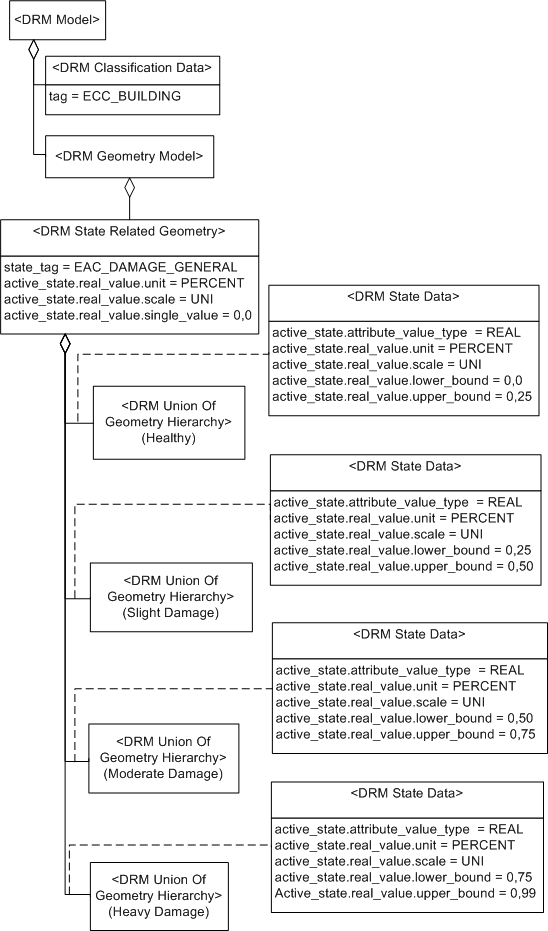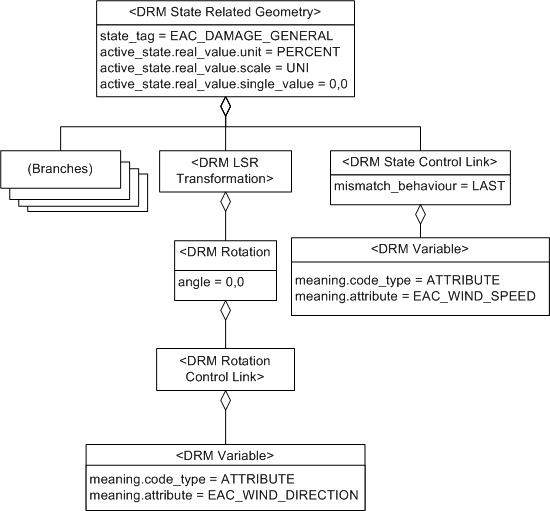Class Name: State Related Geometry
Subclasses
This DRM class is concrete and has no subclasses.
Definition
An instance of this DRM class specifies a state related organization of
<Geometry Hierarchy> components where each
<Geometry Hierarchy> component represents a separate
discrete state from a possibly continuous state value. Each discrete
state corresponds to a branch of the
<State Related Geometry> instance
and is identified by the <State Data> link object
for that branch. The state value itself is specified by the
state_tag
of the <State Related Geometry>
instance.
Primary Page in DRM Diagram:
Secondary Pages in DRM Diagram:
This class appears on only one page of the DRM class diagram.
Example
Consider a <Model> instance of a building that has four
different geometric representations, each representing different
damage states. The <Model> instance therefore has
a <Geometry Model> component, the geometry of which is
organized using a <State Related Geometry> component with
four branches, one for each damage state, as in
Figure 6.67.

Figure 67 — <DRM State Related Geometry> damage example
Each branch of the <State Related Geometry> instance
is specified through a <State Data> link object
indicating the range of percent damage that the branch represents.
The range values in the diagram therefore specify explicitly
the bins in which the states fall.
Consider a slightly different design for the previous example,
modified to allow each <Geometry Model Instance> instance to
specify a percent damage value using a
<State Control Link> instance.
-
A <State Control Link> component is added to
the <State Related Geometry> instance
with mismatch_behaviour
= SE_STMISMBEH_NONE
and a <Variable> instance V as
its controlling <Expression> instance, where the
meaning of V
is EAC_GENERAL_DAMAGE_FRACTION.
-
V is associated to the
<Interface Template> component of the
<Model> instance. If the
<Model> instance has no
<Interface Template> component, one is added.
The
mismatch_behaviour
of the <State Control Link> instance can be exploited to
turn off the <Geometry Model Instance> instance if a
damage value is provided that does not match one of the damage states.
This allows the <Model> instance to not require a totally
destroyed state for 100% damage. If the data provider instead wanted to
keep a state transition from happening until the state value matches a
<State Data> link object,
SE_STMISMBEH_LAST
is specified. The
mismatch_behaviour
is not needed if the <Variable> instance only
takes on valid values.
A wind sock model designed to support a landing site has state behaviour
to allow it to respond to wind speed and wind direction.
The wind sock is modelled with five states of EAC_WIND_RESPONSE,
where the response to wind direction is implemented by using
a <Rotation Control Link> instance with a
<Variable> component having a
meaning of EAC_WIND_DIRECTION
as depicted in Figure 6.68:

Figure 68 — <DRM State Related Geometry> wind example
A <State Related Geometry> instance represents
different states of an aircraft hatch for
EAC_OPENING_COVER_POSITION, one
<State Data> link object with
EEC_OPNCOVPOS_CLOSED and another with EEC_OPNCOVPOS_OPEN.
A <State Related Geometry>
instance represents different damage states of a building for
EAC_GENERAL_DAMAGE_FRACTION with
<State Data> link objects for [0, 25) % damage,
[25, 50) % damage, [75, 100) % damage, and [100, 100) % damage.
To represent a forest as healthy versus burned, a
<State Related Geometry>
instance with state_tag
set to EAC_GENERAL_DAMAGE_FRACTION is used.
FAQs
-
Are <State Related Geometry> instances
the only way to represent multi-state environmental objects in the DRM?
No. <Control Link> instances can be used to
provide a fine level of control
over state by changing fields instead of representing states
as different <Geometry Representation>
instances.
Constraints
Associated to (one-way) (inherited)
Associated by (one-way) (inherited)
Composed of (two-way) (inherited)
Composed of (two-way)
Composed of (two-way metadata) (inherited)
Component of (two-way) (inherited)
- zero or more <Alternate Hierarchy Related Geometry> instances, each through the use of a <Hierarchy Data> link object
- zero or more <Animation Related Geometry> instances
- zero or more <Classification Related Geometry> instances, each through the use of a <Classification Data> link object
- zero or one <Environment Root> instance
- zero or one <Geometry Model> instance
- zero or more <LOD Related Geometry> instances, each through the use of a <Base LOD Data> link object
- zero or more <Octant Related Geometry> instances, each through the use of a <Octant Data> link object
- zero or more <Perimeter Related Geometry> instances, each through the use of a <Perimeter Data> link object
- zero or more <Quadrant Related Geometry> instances, each through the use of a <Quadrant Data> link object
- zero or more <Separating Plane Relations> instances, each through the use of a <Separating Plane Data> link object
- zero or more <Spatial Index Related Geometry> instances, each through the use of a <Spatial Index Data> link object
- zero or more <State Related Geometry> instances, each through the use of a <State Data> link object
- zero or more <Time Related Geometry> instances, each through the use of a <Time Constraints Data> link object
- zero or more <Union Of Geometry Hierarchy> instances
Notes
Associated to Notes
An association between a
<Feature Representation>
instance and a
<Geometry Hierarchy> instance
indicates that the environmental object(s) that they
represent have the semantic relationship indicated by
the <Base Association Data>
link object on the association relationship.
An association between two
<Geometry Hierarchy> instances
indicates that the environmental object(s) that they
represent have the semantic relationship indicated by
the <Base Association Data>
link object on the association relationship.
Associated from Notes
An association between a
<Feature Representation>
instance and a
<Geometry Hierarchy> instance
indicates that the environmental object(s) that they
represent have the semantic relationship indicated by
the <Base Association Data>
link object on the association relationship.
An association between two
<Geometry Hierarchy> instances
indicates that the environmental object(s) that they
represent have the semantic relationship indicated by
the <Base Association Data>
link object on the association relationship.
An association from a
<Hierarchy Summary Item>
instance to a <Geometry Hierarchy>
instance indicates that the
<Hierarchy Summary Item> instance
summarizes that <Geometry Hierarchy>
instance.
An association from a
<Reference Surface> instance to a
<Geometry Hierarchy> instance indicates
that the <Geometry Hierarchy>
instance organizes the geometric objects that specify
the reference surface geometry of the
<Reference Surface> instance.
Composed of Notes
In the case where multiple
<Collision Volume> components are
specified for the
<Aggregate Geometry> instance,
the union
of the volumes thus specified is used in collision detection.
An <Aggregate Geometry> instance can have
an <LSR Transformation> component only when the
<Aggregate Geometry> instance is within
the scope of an LSR 3D SRF.
Fields Notes
If the value of the
unique_descendants
field is SE_TRUE, each
descendant of this aggregation, that is, each
<Geometry Representation>
instance that exists in the component tree
rooted at the <Aggregate Geometry>
instance shall be unique, in the
sense that it shall appear in only one branch
of this aggregation.
If unique_descendants
is SE_FALSE, at least one
<Geometry Representation> instance
appears in more than one branch of the aggregation.
If the value of the
strict_organizing_principle
field is SE_TRUE, each
branch of this aggregation
strictly complies with the organizing principle for its
particular subclass. If this value is
SE_FALSE, at least
one branch does not strictly comply with the given
organizing principle. See the organizing principle constraint
for each specific subclass for details.
The state_tag field specifies
the state by which the
<Geometry Hierarchy> components
are being differentiated and shall specify an EAC that qualifies
as state applicable.
The active_state_value field
specifies the default state. If the
<State Related Geometry> instance has a
<State Control Link> component, the value of the
active_state_value field
is obtained from that
<State Control Link> instance.
Prev: State Related Features.
Next: Strobing Light Behaviour.
Up:Index.

